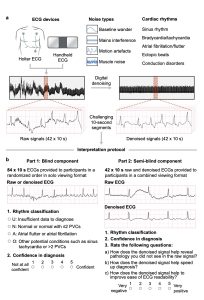5 September 2024
Case Study: Enhancing the Efficiency and Accuracy of ECG Interpretation Through Digital Denoising with HeartKey
Background
The interpretation of ECGs is a crucial skill in healthcare, used across various medical disciplines to diagnose and manage cardiac issues. Adept interpreters rely on a combination of pattern recognition capabilities and advanced cognitive functions to discern pathological deviations in the ECG, contingent upon the clear identification of diagnostic features. However, deficiencies in the ECG interpretation abilities of healthcare professionals are a longstanding concern within the medical community. Major errors have been reported in up to 33% of ECG interpretations1, and as many as 11% of these errors lead to inappropriate patient management2. Recent studies have highlighted the considerable variation in ECG interpretation accuracy between healthcare professions and experience levels3,4.
Among training and educational factors that impact the ability of healthcare professionals to interpret an ECG accurately and confidently, the presence of noise and artefacts originating from non-cardiac sources can play a significant role. Artefacts that mimic the morphology of pathological features can simulate non-existent arrhythmias and cardiac abnormalities, including atrial fibrillation, ventricular tachycardia, and myocardial ischemia, resulting in erroneous diagnoses and potentially inappropriate interventions. Furthermore, excessive noise interference can distort or obscure the underlying signal, rendering significant portions of recordings clinically unactionable. This can potentially result in missed or delayed diagnoses, a problem that is exacerbated in the ambulatory setting.
The Challenge
Despite the established correlation between noise and erroneous diagnoses, research evaluating the impacts of digital denoising software on clinical ECG interpretation ability of healthcare professionals is lacking, making it difficult to justify the integration of innovative technologies like HeartKey within clinical workflows.
Study Aims
B-Secur, in collaboration with the Allan Lab at Jersey General Hospital, conducted this pivotal study to explore the impact of advanced digital denoising software (HeartKey) on improving the interpretive capabilities of healthcare professionals (lacking in the literature).
Study Design
The study involved a diverse cohort of 48 healthcare professionals with a range of different experience levels, who assessed a series of single-lead ECG recordings using a blinded protocol that compared their ability to confidently diagnose cardiac rhythms with and without the aid of HeartKey denoising.
Impacts on Interpretive Capabilities
Signal denoising through HeartKey significantly improved diagnostic rhythm classification accuracy and confidence among the healthcare professionals (relative to raw signals):
- 4.9% increase in rhythm classification accuracy.
- 6.2% improvement in diagnostic confidence.
- 9.7% reduction in data deemed undiagnosable.
Participant comments on the impact of HeartKey on the interpretive process:
“More confidence in my diagnosis with less ECG artifact” – Participant 16, Cardiologist
“Improves confidence, as the raw strip has significant area of interference and therefore difficult/unable to use” – Participant 14, Junior Doctor
“Significant removal of baseline artefact revealing AF more easily” – Participant 5, Consultant Cardiologist
Participant Perception of HeartKey Denoising
Participants had a predominantly positive perception of digital denoising as it relates to the three aspects of clinical ECG workflow that were assessed:
- 51% stated a ‘positive’ or ‘very positive’ impact of HeartKey on revealing previously unseen pathologies in the raw signal.
- 65% stated a ‘positive’ or ‘very positive’ impact of HeartKey on speeding up diagnosis
- 74% stated a ‘positive’ or ‘very positive’ impact of HeartKey on improving the ease of ECG readability
Implications for Clinical Workflow
The findings from this study underline the potential of digital denoising technology to transform ECG interpretation practices. By integrating HeartKey into their workflow, healthcare providers can achieve:
- Quicker, more confident decision-making based on clearer ECG data.
- Fewer diagnostic errors due to noise, leading to better patient outcomes.
- Reduced healthcare costs and improved efficiency by minimizing the need for repeated tests.
Conclusions
This case study highlights B-Secur’s commitment to pioneering solutions that address practical challenges in cardiac care. HeartKey’s ability to enhance the interpretive accuracy and confidence of ECG data not only supports healthcare professionals in their daily duties but also aligns with broader goals of improving patient care through technological innovation.
1 Mele P. Improving electrocardiogram interpretation in the clinical setting. J Electrocardiol 2008;41:438-439.
2 Breen CJ, Kelly GP, Kernohan WG. ECG interpretation skill acquisition: A review of learning, teaching and assessment. J Electrocardiol 2022;73:125-128.
3 Cook DA, et al. Accuracy of physicians’ electrocardiogram interpretations: a systematic review and meta-analysis. JAMA Intern Med 2020;180:1461–1471.
4 Kashou AH, et al. ECG interpretation proficiency of healthcare professionals. Curr Probl Cardiol 2023;48:101924.

